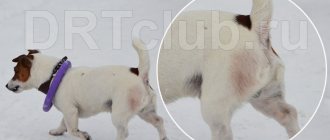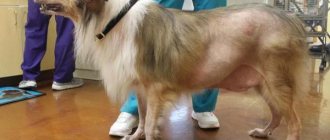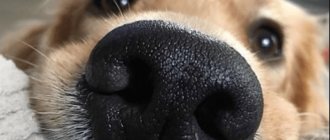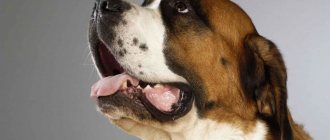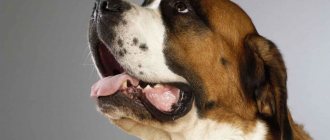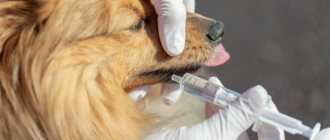Surely some pet owners have encountered the fact that their dog’s nose becomes lighter. And this, of course, is alarming, because many dogs make a show career. And hypopigmentation (weakening of pigmentation) plays an important role when grading an animal.
Thoughts immediately begin to pop in: Is everything okay with my furry? Is sudden lightening of the nose a sign of some disease?
As a dog breeder, every now and then I have to deal with one problem or another. And I have already learned not to panic about every reason, but to look for an explanation for this or that change that happened to my Jack, be it an allergy or demodicosis.
So the problem of a light nose also did not pass us by. So what is the reason for this phenomenon? Let's try to figure this out together.
Natural factors
Most quadrupeds have black noses. And this is the standard.
But, there are some natural factors where a light nose is quite common.
Congenital light pigmentation
There are some breeds where light or brown pigmentation is normal.
For example, the Rhodesian Ridgeback. Depending on the color of their coat, dogs of this breed can have a black nose and dark eyes, or a brown nose and amber eyes. Ridgebacks with sand-colored noses are born very rarely and fully comply with the standard, which is why they are of particular value.
Another breed with a standard light nose color is the Weimaraner. This is a beautiful and stately breed of dog. Their nose is dark flesh-colored, gradually turning gray towards the back.
Albino dogs
Albino dogs, considered a breeding match, typically have light and pink noses. And for such four-legged animals, such a phenomenon is also quite natural, and a light nose is not a sign of illness.
Weather
The most common factor for a dog's light nose is weather conditions:
- In summer it is the sun's rays. Everyone knows that black color has the least reflective ability, so it attracts golden rays more than others. Under the scorching sun, a black nose simply fades and acquires a light shade. However, it should be remembered that prolonged exposure to solar ultraviolet rays can lead to the development of tumors and cancer. Therefore, if you are relaxing at sea, or live in a hot climate where the number of sunny days is simply off the charts, you should take care of the safety of your pet. Use special sunscreens for four-legged animals. To protect the nose, a spray is more suitable than a cream. The liquid is instantly absorbed, which prevents cosmetics from being licked off.
- Another natural factor for changing the color of a dog’s nose is the cold season. There is such a thing as a “winter nose”. Just like people, in winter the noses of some four-legged animals become lighter, as they say: due to lack of tanning. Daylight hours are shortened, there are fewer sun rays, the nose loses pigment and acquires a uniform light shade. With the onset of warm days, pigmentation is restored and the lobe turns black again. When experts began to study such a phenomenon as the “winter nose,” they were unable to unravel such a phenomenon. All research has come to a standstill. Therefore, to this day, “winter nose” is considered a completely common seasonal phenomenon.
However, if you do not want to wait for the nose to turn black with the arrival of spring, and there is an important exhibition ahead, it is recommended to additionally add vitamin E to the four-legged diet, which enhances pigmentation. This vitamin is found in sprouted wheat, bran, broccoli, sunflower and olive oils, buckwheat, parsley, fish and beef liver.
Preparations with seaweed or kelp in its pure form are also useful for pigmentation. When Jack's nose becomes lighter in winter, I buy regular dry seaweed (without additives) at the pharmacy and add half a teaspoon of it to his food every 2-3 days. But, it should be remembered that seaweed tends to stain wool. Therefore, if you have a white dog, then before the exhibition it is better not to get carried away with them, as the coat may acquire a yellowish tint. But if you have a red dog, then for the brightness of the color of both the coat and the nose, this is the best option.
The “winter nose” should not be confused with genetic disorders, when individual light stripes or cobwebs appear on the nose.
Age-related changes
Most puppies of various breeds often have uncolored noses. Moreover, for some they are completely pink, for others with pink splashes, and for others, already at a young age, the nose becomes completely black. With age, the nose darkens, and all pink spots are painted over with dark pigment. But this is not always the case. No one guarantees that the nose will be completely colored. However, this does not in any way affect the health of the four-legged animal. But, unfortunately, if this does not happen, then for most breeds this is a breeding marriage. Although, this has a kind of charm, doesn’t it?
Old age in dogs can also cause pigmentation disorders. With age, the metabolism in the animal's body slows down. A substance such as melanin, which is responsible for the formation of pigment, is produced more slowly. Therefore, a “snow nose” formed in winter can remain that way for the rest of your life.
Damage to the nose
Everyone knows that four-legged animals simply love to dig. Hunting dogs have a special love for this activity. In search of “prey,” our Jack can dig holes in the ground for hours. After his “excavation work” in such places, you can easily go and plant trees without the help of a shovel... Well, in any case, you need to walk on such a “battlefield” with caution, otherwise you can easily fall into some kind of “funnel”. As a result of such active walks, the top layer of nasal cells is simply mechanically erased. And it takes time to restore the pigment.
In addition to abrasion, other damage may occur: burns, scratches as a result of a fight, and so on. Such damage is dangerous because during the healing process the pet can tear off the resulting scab. This is fraught with the appearance of a scar that remains forever, since scar tissue always has a lighter shade than the skin itself.
Causes of depigmentation of the nose
Some pets with too light noses behave like completely healthy animals. Only with a thorough examination can a veterinarian determine the problems causing metabolic disorders and lack of melanin levels.
Most often, depigmentation of the lobe occurs when:
- liver diseases;
- chronic pancreatitis;
- problems with the gastrointestinal tract;
- hormonal disorders.
Important! Seeing that the dog’s nose is becoming lighter, most owners begin to take measures to normalize the situation and thus cause even more harm to the pet. Only a veterinarian can determine the cause.
It is recommended to undergo an annual examination so that if changes occur, you do not have to worry that they may be due to illness.
Household factors
In some cases, everyday causes can also cause nasal hypopigmentation in an animal. What can be attributed to such factors?
Dry air
Dry air in a living space is a very common story. This problem is especially typical in the winter, when heating radiators are “scalding to the fullest.” Not only pets, but also people suffer from this. The skin becomes dry and peeling appears. The four-legged fur dries and becomes brittle. In addition to loss of pigment, the nose may also become dry and cracked. To prevent this from happening, ventilate your home regularly. However, while one room is being ventilated, it is better for all household members to stay in another. Otherwise, cold air and drafts can cause colds in both people and pets.
I always ventilate the apartment when Jack and I go for a walk.
Allergic reactions
Often, incorrectly selected household items can cause allergic reactions, which in turn manifest themselves in the form of irritation of the mucous membranes, dermatitis, hair loss, and so on. An incorrectly selected shampoo or things that the animal is constantly in contact with can cause discoloration and peeling of the nose, the appearance of bald patches and wounds on the skin.
Thus, some plastic or rubber products, such as plastic food bowls, contain melamine. It is the main component for making plastic. Thanks to it, plastic products do not break and are heat resistant. But not everyone knows that upon contact with food and liquids, plastic releases formaldehyde, which is very dangerous and harmful to both animals and humans. Long-term use of such dishes can cause allergic reactions, skin diseases, inflammation of the mucous membranes of the nasolabial part, impaired pigmentation of the dog’s lips and nose, tumors and poisoning.
Therefore, first of all, you need to find out what your pet is allergic to, and then eliminate its cause. And if you use plastic bowls to feed your pet, then they should definitely be replaced with metal ones.
What to do at home
The appearance of spots on the skin, changes in coat color in dogs - all these insidious abnormalities cannot be treated on your own.
Without specific diagnostics in a veterinary clinic and finding out the main cause of the changes that appear, it is impossible to alleviate the animal’s condition.
Therefore, at home you should follow all doctor’s prescriptions, and if the diagnosis of lupus is confirmed, you should protect your dog from exposure to ultraviolet rays.
The use of ointments and medications selected by a doctor will speed up your pet’s recovery.
Pathologies and diseases
A sudden change in the color of a dog's nose may be the first sign of any disease. As a rule, if the lightening of the lobe is caused by a disease, then other symptoms are also present.
Bacterial infections
Very often, bacterial infections cause a dog's nose to become lighter. Infection can occur either by contact or by airborne droplets. Dogs that are kept in unfavorable conditions are most susceptible to this disease. An unbalanced or incorrectly selected diet can also cause your pet to become infected with bacterial infections due to weakened immunity.
In addition to the lightening of the nose, infections may be accompanied by the following symptoms: loss of appetite or refusal to eat, weight loss, fever, lethargy, drowsiness, irritation or pallor of the mucous membranes, runny nose, tears from the eyes, dermatitis, deterioration of the coat, baldness, and so on.
It is not at all necessary that all of the above symptoms will occur all at once. But, if the color of the nose changes, you should pay extra attention to your pet. At least until you are absolutely sure that the lightening of your nose is not associated with illness.
Neoplasms and tumors
Neoplasms and tumors can also lead to lightening of a dog's respiratory system. If the skin on your nose dries, becomes scaly, becomes lighter and cracks, the wounds do not heal, and the condition only worsens, you will most likely be offered a biopsy to make an accurate diagnosis. Only after this the doctor will prescribe treatment.
Lupus
Simply put, lupus is a strange behavior of the immune system, which, out of the blue, suddenly becomes super protective and “attacks” the cells and tissues of its own body, mistaking them for enemies. The following dog breeds are believed to be predisposed to the disease: German and English shepherds, collies, shelties, poodles and Irish setters.
As a rule, the disease appears when the pet reaches the age of six and is characterized by the following symptoms: nosebleeds, loss of pigment and damage around the nose and throughout the face, ulcers, light plaque, baldness, general weakness.
All these symptoms do not pose a serious threat to life. But, complications may develop that will lead to joint pain, problems with the kidneys and lymph nodes.
This disease is very difficult to diagnose, and the reason why it may develop has not yet been determined. There are suggestions that this pathology is genetic. Therefore, to make an accurate diagnosis, a complete blood and urine test is required. Veterinarians have found that animals that spend most of their time outdoors are most susceptible to the disease. Fungal and bacterial infections can also cause lupus.
No veterinarian guarantees a complete cure for this disease. Therapy is mainly aimed at reducing skin lesions, joint pain and relieving stress on the kidneys.
Pemphigus
Another immune system disease similar to Lupus is pemphigus, which can develop regardless of the breed or age of the pet. The cause of the development of the disease can be: ultraviolet rays, fungal or infectious diseases, excessive “hobby” with medications. Pimples filled with fluid or pus appear on the nose, eyelids, near the ears, on the pads of the paws and on the stomach. Over time, the pimples burst and the contents flow out, forming scabs and wounds.
After some time, the crust falls off, taking with it the upper layers of the skin, resulting in depigmentation.
Vitiligo
Vitiligo is a disorder in the production of melanin, which is responsible for the color of the skin and fur of a four-legged animal. The nose and some areas of the body become lighter in color. More than others, Labradors, Huskies, Irish Setters, and Dachshunds are predisposed to this type of depigmentation. The so-called “snowy nose” is one of the forms of vitiligo.
Vitiligo is a fairly rare condition that cannot be cured. This pathology does not affect the health of the four-legged animal in any way. Only the color changes. Dogs are not at all contagious, however, such a barbosie will no longer be able to make a show career.
Vitiligo can affect not only dogs, but also other animals and even people. Although this is a pathology, it looks fantastic, somehow unearthly.
Dudley's nose
Another genetic pathology for which scientists have not yet found an explanation. As a rule, yellow Labradors have a tendency towards this type of natural “joke”. Dogs' nose color begins to change for no apparent reason. As it matures, it turns brown and sometimes even pink.
Today I tried to talk about the most common cases when a dog’s nose becomes lighter and why this happens. Yes, the lack of dark pigment on the nose is considered a show fault. But, in most cases, it does not cause any harm to the dog’s health.
Therefore, if your pet’s nose suddenly turns lighter, don’t get upset right away. Just pay special attention to the tail. Look for other symptoms that may indicate the presence of the disease. If everything is in order, love your handsome net-nosed boy the way nature suddenly wanted him to be. This means he is special to you.
Good luck and take care of your pets!
Possible complications
If pigmentation is genetically based, the condition of the spots should be monitored. If a red halo (a sign of inflammation) appears around them, you should consult a doctor.
Self-medication is unacceptable. A dangerous infection can develop in a dog’s body, and assistance provided untimely will require either long-term severe treatment or will not be able to overcome the advanced form of the disease.
Mite infestation
Symptoms:
— Often the animal is worried about the attached tick: it itches, shakes its head if the tick has got into the ear.
— Rapid rise in body temperature to 41-42°C. This is the dog’s body’s response to the introduction of the parasite.
— At the site of the bite, two to three hours after removing the parasite, pronounced local redness is observed.
- Swelling, increasing in radius from the center of the bite, increased skin temperature in this area, redness, itching and pain.
— The animal licks and scratches the bite sites.
— Animals refuse to eat, show drowsiness and apathy.
— If a lump appears at the site of the bite, this may be the result of an allergy to the saliva of the parasite or infection of the wound or the tick head remaining in the wound. Hair may fall out at the site of the bump, and the dog reacts painfully to touching it. Purulent inflammation at the site of the bite appears due to the introduction of pyogenic microbes into the open wound.
— Some of the listed symptoms may appear: trembling, thirst, shortness of breath, pale mucous membranes, abdominal pain, foul odor from the mouth, blood in the urine, vaginal bleeding (in bitches), impaired motor reflexes: unsteadiness of gait, paralysis of the hind limbs (“tick-borne”) paralysis"), dysphonia (the dog cannot bark), dysphagia (lack of swallowing), sometimes vomiting and diarrhea and some others.
Treatment:
1. Remove the tick.
2. Disinfect the wound.
3. Use of antiparasitic drugs after consultation with a veterinarian.
Prevention:
- Anti-tick drops.
— Antiparasitic collar.
— Protective overalls.
============================================================================================================================================================================================
Pododermatitis
Pododermatitis is an inflammation of the delicate skin of the paws between the toes.
It occurs most often between October and March, when roads and paths are sprinkled with the reagent. As a rule, this is salt, but reagents with added chemicals are most often used.
The most susceptible breeds are those with short hair and often without undercoat (Dobermans, Great Danes, Shepherds, Bulldogs, Pinschers, Toy Terriers, Chihuahuas, etc.).
Symptoms:
— The dog constantly licks its paws, chews them, and limps.
— Paw pads are red and wet.
— The disease manifests itself as sores on the pads.
- Vesicles filled with blood form on the paws.
- A characteristic sign is swelling of the paws.
Treatment:
1. First of all, you don’t need to wash your paws with an alkaline solution every time you walk: soap, shampoo or gel. With this treatment, the skin becomes susceptible not only to reagents, but also to pathogenic bacteria, and this can lead to more serious diseases.
2. Antiseptics and antibacterial agents are prescribed for treatment.
Prevention:
— Before a walk, rub the pads with paraffin or a special product that is sold at a veterinary pharmacy.
— After a walk, wash off the reagent and all dirt with running water, without any means.
- Use shoes for animals.
============================================================================================================================================================================================
Dermatophytosis (lichen)
Dermatophytoses are infectious diseases of keratinized tissues (skin, hair, nails) caused by fungi of the Microsporum, Trichophiton or Epidermophiton species.
LOCALIZATION PLACES
In everyday life, all these diseases are called lichen. Ringworm is transmitted to humans!
There are several types of dermatophytoses, similar in symptoms:
- ringworm;
- trichophytosis;
- microsporia;
- favus.
Symptoms:
1. Peeling of the skin with signs of hair loss.
2. Inflammatory process on the skin, sometimes with purulent discharge.
3. Itching.
4. Baldness.
Treatment:
1. For small lesions, ointments are used
2. Lime sulfur solution; miconazole solution; povidine iodide; rinsing solutions containing chlorhexidine. The dog's ears are treated separately using cotton swabs.
3. In especially severe cases, when large areas of the body are affected, fulcin, grisin and biogrisin are used.
============================================================================================================================================================================================
Non-food allergies (Atopy)
SITES OF LOCALIZATION
“Atopy” is an allergic reaction to everything else except food. For pollen, dust mites, flowers, chemical components contained in detergents, and much more.
Symptoms:
- Severe skin itching, causing great discomfort to the animal.
— Skin damage, scratching, abrasions (especially in the area of the muzzle and paws), which appear due to the fact that the dog constantly itches and tears the skin with its claws. An infection that gets into the wounds provokes the appearance of boils, hyperpigmentation, and ulcers.
- Hair loss, alopecia.
— A characteristic smell from the ears, reminiscent of fermented yeast dough.
— Focal lichenification is a structural change in the skin.
Additional signs of atopic dermatitis include:
- excessive dryness of the skin;
- immediate reaction to the allergen;
- external form of allergic otitis;
- superficial manifestations of staphylococcal infection.
The severity of the disease is determined by factors such as the area of skin lesions, the duration of exacerbations and remissions.
Treatment:
1. Corticosteroids are required. These drugs are hormonal, their action is aimed at eliminating itching, allergic swelling, and redness. Prednisolone, Methylprednisolone, Dexamethasone, etc. are most often prescribed.
2. The doctor also prescribes antihistamines: Lominal, Zyrtec, Claritin.
3. For old dogs, it is advisable to prescribe Telfast, Gismanal, Trexil - third and fourth generation drugs.
4. Tricyclic antidepressants are sometimes prescribed - Amitriptyline, Pyrazidol, Trimipramine.
5. Cyclosporine, Oxpentiphylline, Misoprostol or Fluoxetine will help cope with itching.
============================================================================================================================================================================================
Establishing diagnosis:
The diagnosis of Malassezia dermatitis is made based on history (age of onset of symptoms, breed), clinical examination (considering the number and appearance of affected areas), diagnostic tests and response to trial treatment.
As a diagnostic test to detect an increased number of Malassezia fungi, fingerprint smears from the affected skin and external auditory canal are used, which the doctor can examine during the appointment. By assessing the amount of yeast in the preparations and comparing this with the appearance of the lesions, the veterinary dermatologist can draw conclusions about whether yeast is the cause of the inflammation.
It is important to remember that lesions in atopic allergic dermatitis, parasitic dermatoses (sarcoptic mange and demodicosis) and various keratinization disorders (keratinization of epidermal cells) may have a similar appearance, but the number of yeast fungi may not be increased. Therefore, self-prescribing antifungal drugs to a dog without a visit to a doctor may be unjustified.
Food allergies
PLACES OF LOCALIZATION
Food allergies occur to new components in food. Either it is proteins, or fats, grains, vitamins.
Symptoms:
- Severe skin itching. The dog constantly scratches his skin and ears, and tries to literally “rub his eyes” with his paws.
- The ears and eyes “run”, the dog develops a characteristic sweetish-sweet smell, which gradually intensifies. The discharge is initially liquid and colorless, but when infected it becomes purulent. Brown masses accumulate in the ears, yellowish ones in the corners of the eyes, especially noticeable after sleep.
— Skin scratches merge into bright pink spots, and a semblance of dandruff appears.
- Then the hair begins to fall out (alopecia areata).
— The next stage is the transition of dry eczema to weeping; The skin under the armpits, in the groin, and around the anus is affected.
— Digestive problems: loss of appetite and lethargy, rumbling in the stomach, diarrhea.
— Putrid odor from the mouth, foamy vomit mixed with bile, then swelling of the small intestine (reactive enteritis) and its obstruction increases.
Treatment:
1. Selection of hypoallergenic food, where the source of protein is lamb, duck or salmon, carbohydrates are corn and rice. For older dogs, a diet low in zinc, phosphorus and sodium is recommended.
2. Use of systemic antihistamines and anti-inflammatory drugs to eliminate itching and swelling.
3. Use of ointments and creams with a desensitizing and wound-healing effect.
4. Bathing the animal using shampoos containing corticosteroids, cooling and soothing components.
5. Prescription of systemic and local antibacterial and antifungal agents to combat secondary microflora.
============================================================================================================================================================================================
Cheilitis (seizures)
Cheilitis in dogs, or in simple terms - seizures, inflammation of the mucous membrane of the lips with a transition to the skin.
Symptoms:
— Cause an unpleasant sensation, irritation, pain and itching. The animal tries to eliminate the discomfort by rubbing its muzzle against objects, the ground, and pulling with its paws.
— At the junction of the edge of the lip and the skin, dead white pieces (scab) appear.
— The scab peels off, falls off, and small, weeping and painful wounds form.
— Sweaty nodules form at the site of the hair follicle, and when they are opened, pus is released.
— An inflammatory process develops in folds and wrinkles on the lower lip, especially at the point of contact with the upper fangs.
- Wetting in the folds of the lips and jowls.
Treatment:
1. For fungal cheilitis, antifungal drugs that suppress the activity of Candida (Levorin, Nystatin) are prescribed, and the dog’s mouth is irrigated with antiseptic solutions (Miramistin, Chlorhexidine).
2. For eczematous cheilitis, antihistamines are used (Diphenhydramine, Suprastin), the affected mucosa is lubricated with corticoid-based ointment (Prednisolone, Sinalar).
3. It is recommended to treat the mouth with a 3% solution of baking soda 2-3 times a day, smear it with a mixture of glycerin and borax (20:5).
4. Vitamin and mineral complexes that strengthen the dog’s immune system and immunostimulant drugs are required.
============================================================================================================================================================================================
Cushing's syndrome
LOCATIONS
Cushing's syndrome in dogs or hyperadrenocorticism is one of the most common diseases of the endocrine system in dogs, which occurs when excessive production of the hormone cortisol by the adrenal glands (located in the abdominal cavity) or adrenocorticotropic hormone by the pituitary gland (located in the brain).
Symptoms:
- Increased thirst and urination.
- Increased appetite.
- Obesity.
- Skin changes may be characteristic (alopecia without signs of itching, thinning and inelasticity of the skin, comedones).
— Muscle weakness/wasting, sagging abdomen (“pot-bellied” appearance).
— Disturbance of the reproductive cycle in females and atrophy of the testes in males.
- Noisy and rapid breathing.
— Neurological signs.
Treatment:
1. Drug treatment in the form of tablets (ketoconazole, mitotane, etc.).
2. Surgery (for unilateral adrenal tumor).
===========================================================================================================================================================================================
Why does a dog's nose turn pink?
There are not only light, but also pink noses on dogs. There may be several reasons for this feature:
- Presence of mites, demodicosis.
- Flea dermatitis.
- Lichen.
- Presence of bacteria.
Important! These reasons explain why a dog has a pink nose.
It can also turn pink for natural reasons:
- Weather. In winter, in the cold, the lobe may turn pink.
- Elderly age. The hormone melanin is produced more slowly, and this is the reason for the color change.
- Injury. As a result of impacts, oral diseases and dental problems, the color may also change.
- Infection. A bacterial infection may appear as a change in color.
- Allergic reaction. Under the influence of an allergen, the pigment changes.
Many owners, noting that their pets are worried about the changes that are taking place, ask the question - what to do if the dog’s nose has turned pink? Of course, you should contact a veterinarian who will conduct an examination and tell you why and what measures should be taken. By the way, some experts recommend, under such circumstances, enriching the animal’s food with algae.
Important! Due to natural causes, swelling should not occur or plaque should form on the mucous membrane.
Demodicosis
LOCATIONS
Demodicosis in dogs is a parasitic disease. Caused by microscopic mites of the genus Demodex, which feed on skin and loose fiber.
Symptoms:
— At the beginning of the disease, severe itching appears, the dog itches for several hours in a row. Then redness at the base of the hair becomes visible. After a few days, bubbles appear at the site of redness with contents that are first brick-colored and then clay-colored. Within 3 - 4 days, hair falls out at the site of the lesion, the bubbles burst, releasing the foul-smelling contents. This is how the pustular or pustular form of demodicosis manifests itself. If there are less than five spots of hair loss, they speak of a local lesion. If 5 or more spots are visible on the dog’s body, a generalized form is diagnosed.
— Dry scales are often found on the body, sticking the fur together. The scales may resemble sun-bleached dirt, bran, or fish scales. After a few days, the scales fall off along with the dog's fur. Pus is visible underneath them.
— In severe cases, the dog is depressed and refuses food. Body temperature can drop to 37 degrees.
Demodicosis can last for years. Without qualified help, dogs die from exhaustion or blood poisoning.
Treatment:
1. Macrolytic lactones, which include avermectins and milbemycins. Avermectins should only be given orally (with food, drink), these include Novomek, Baymek, Ivermag (actually ivermectins) and Dectomax (it is related to doramectins). What about milbemycins? Milbemax, an interceptor, for example.
2. To destroy adult ticks that find themselves near blood vessels, use ivermectin or doramectin preparations. Ivermectin is deadly to Collie and Sheltie dogs; these animals are administered only doramectin under the supervision of an experienced veterinarian.
To destroy the causative agent of demodicosis in dogs, use yam or aversectin ointment.
3. The use of formamidines (amit, bipin, certificate, amitan) is also necessary. Do not forget about drugs related to fluralaners and afoxolaners (the best “representatives” are Bravecto and Nexgard).
4. There is also a “subgroup” - moxidectins (it includes drugs such as “Advocate” and “Cydectin”).
5. To restore the integrity of the skin, wound healing and antiseptic drugs are used.
============================================================================================================================================================================================
